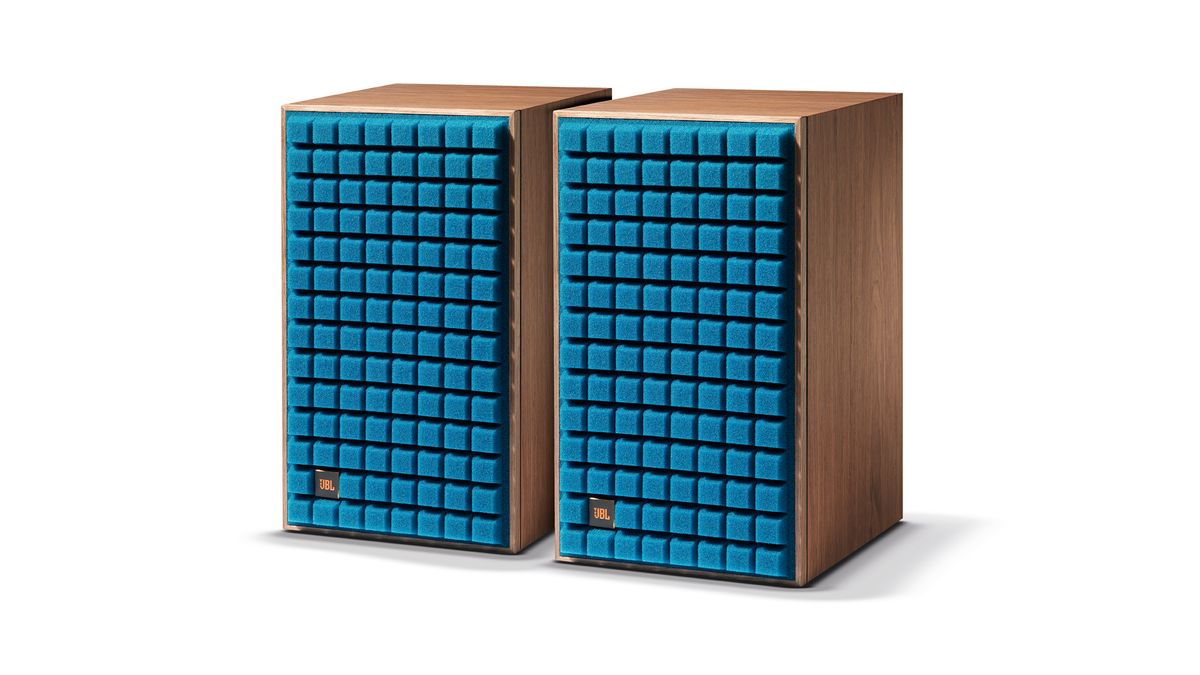What Hi-Fi? Verdict
If the L82 Classics align with your tastes then dive right in, but these are no all-rounders
Pros
- +
Full-bodied presentation
- +
Capable of loud volume
- +
Good bass depth
Cons
- -
Not for all kinds of music
- -
Lack sonic subtlety
- -
Optional stands not the best
Why you can trust What Hi-Fi?
The JBL L82 Classic speakers would seem to be the ideal solution for those who want some of JBL's extrovert retro character, but can’t afford to stretch their budget into the thousands, or accommodate something with the frontal area of a small fridge.
We're thinking particularly of the JBL L100 Classic speakers, which made quite a splash when we reviewed them last year. At £3995 ($4000), they offered a charming, nostalgia-fuelled alternative to the conventional mainstream options. They’re big, bold and fun, delivering a listening experience that’s quite unlike anything else we’ve heard for the money.
If the L82 Classics can deliver that at around half the cost, then JBL may be onto another winner.
Build
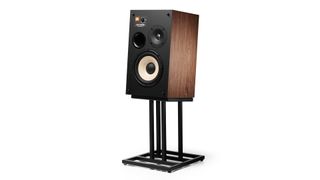
These two-way standmounters get off to a great start. Despite being around half the size and a driver down on their illustrious siblings, they still look every inch a JBL Classic speaker.
It starts with the traditional wide yet shallow cabinet proportions, and extends to the distinctive white paper pulp cone of the 20cm mid/bass driver. As with the L100s, there’s a nod to the past with a front panel dial that lets the user adjust the high-frequency output level. We left this on the 0dB default setting for the bulk of our listening, but it could well have uses in rooms where the sound is skewed tonally.
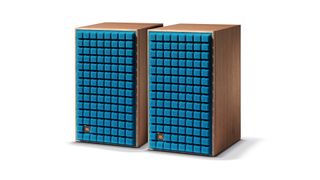
Type 2-way bookshelf loudspeaker
Impedance 8ohm
Sensitivity 88dB
Frequency response 44Hz to 40kHz
Crossover frequency 1.7kHz
Dimensions (hwd) 47.3 x 28.1 x 31.5cm
Weight 12.7kg
It would be easy to dismiss the L82 Classics as a mere marketing exercise aimed at those who yearn to live in the past, but that would be a mistake. Their appearance may hark back to simpler times but the engineering certainly doesn’t.
The mid/bass driver is a bang-up-to-date unit with carefully optimised chassis and motor system designed with some of the most sophisticated facilities around. It’s tuned with a front-firing reflex port and crosses over to the 25mm titanium tweeter at 1.7kHz. This tweeter is the same as used on the L100s, but in that application the crossover point is set far higher at 3.5kHz. As before, there’s a dished waveguide around the dome to help with dispersion.
We don’t have any real grumbles when it comes to build. The enclosure feels suitably solid and the cabinet edges are nice and crisp. There isn’t the slickness of finish that we’re used to seeing from the likes of KEF, Dynaudio or Bowers & Wilkins, but the walnut veneer option looks nice enough.
While we rarely write much about speaker grilles, they’re a bigger deal here because their geometric design is a clear link back to the original L100s from the 1970s. There’s a choice of three colours – black, dark blue and the iconic orange.
The company makes dedicated stands to suit the L82’s distinctive appearance. The £175 ($250) JS-80 are neatly welded supports that lift and angle the speakers appropriately for most listening situations.
While they may be the obvious choice, we’re not convinced they’re the best one sonically. We found that the L82s speakers sound considerably cleaner and punchier in the bass when sat on the similarly priced Custom Designs FS104 Signatures.
Compatibility
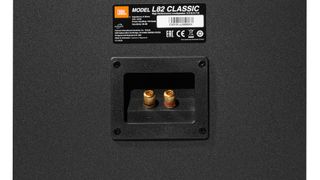
It takes a bit of work to get the best from these boxes. We’ve mentioned the stands, but room positioning plays a large part too. After playing around, we end up with the speakers around 40cm from the rear wall, well away from the sides and slightly angled in towards the listening position.
These standmounters are made in mirror image pairs with the tweeters offset. There’s no indication from the manual as to whether they should be on the inside or outside edge, so we try both ways. Having the tweeters on the outside gives us a broader soundstage, but we gain a more solid presentation when they’re on the inside edge, so that’s how we leave it.
You’ll have to be careful about system matching. That titanium dome tweeter sounds less refined here than in the L100s, probably because it has a much wider frequency band to cover. Partner the L82s with smooth, controlled electronics and there won’t be an issue unless the speakers are provoked with particularly aggressive recordings.
These are relatively big standmounters for the money and pack a correspondingly large mid/bass unit. Remember this is a 20cm unit where most of the competition packs 17cm at most, and those extra centimetres help give these boxes a pretty impressive bass reach. These speakers are relatively fast and controlled at low frequencies, though perhaps not the most tuneful.
Sound
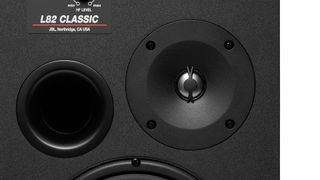
If you’re looking for sonic neutrality, finesse or the last word in resolution these aren’t the boxes for you. If you value such things have a listen to the likes of the mighty ATC SCM19 speakers, or even the cheaper but excellent KEF R3s. Both will serve you better. But that doesn’t stop the JBL L82 Classics from having appeal. They’re full of character, fun and sometimes charming, as long as you listen to the right kind of music.
That kind of music is anything that benefits from an upfront, wall-of-sound approach to replay. Play Nirvana’s Nevermind and the L82s respond with enthusiasm, pounding out the beats with purpose and an impressive sense of power. Cobain’s vocals come through with clarity, each word cutting like a buzzsaw through the instrumental backdrop.
If you like listening to music loud then these boxes are happy to oblige. But, the surprising thing is that they stay interesting even when volume levels drop to a whisper, which is something that can’t be said about most rivals. This is worth considering if you listen late at night or don’t want to upset your neighbours.
But, when a bit of delicacy is required, the L82 Classics are less convincing. Feed them something low-key such as Found Songs by Olafur Arnalds and they’ll shrug metaphorically and smooth the dynamic nuances and blur timing subtleties that make this album so emotionally affecting. Low-level details such as instrumental textures and reverb aren’t ignored, but are quickly marginalised for something more forceful.
The result is that we soon revert to the likes of Kanye West’s Yeezus, where the L82s feed off the music’s aggression and energy to deliver an entertaining sound.
While the bigger L100 Classics have an element of this character, they never go as far. We still enjoy listening to subtler music due to their midrange clarity and dynamic discrimination. These L82s simply aren’t as broadly talented, even when their lower price is taken into account.
Verdict
Despite their imperfections, these JBLs remain entertaining performers in the right circumstances. If you find that the L82 Classics align with your musical and aesthetic tastes, dive right in. There are certainly more capable alternatives at this level, but few that have such a distinctive flavour.
SCORES
- Sound 4
- Compatibility 4
- Build 4
MORE:
What Hi-Fi?, founded in 1976, is the world's leading independent guide to buying and owning hi-fi and home entertainment products. Our comprehensive tests help you buy the very best for your money, with our advice sections giving you step-by-step information on how to get even more from your music and movies. Everything is tested by our dedicated team of in-house reviewers in our custom-built test rooms in London, Reading and Bath. Our coveted five-star rating and Awards are recognised all over the world as the ultimate seal of approval, so you can buy with absolute confidence.
-
Renfrew I had the original 100's and they looked cool but their limitations was that they colored the sound in addition they had to be placed in certain locations to where one sat.Reply
Everything had the L100 sound and no matter what was played-- that's what it was.
I then discovered Allison speakers which blew me away because there was an entirely different sound. I just switched from the California sound to the New England sound and there was just no comparison. The soundstage just opened up with the various Allisons speakers I owned and consequently the JBL's were sold. The Allisons had tweeters which made it possible to appreciate high end frequencies emanating from an off-axis location and the music was more laid back. I still own a pair of JBL L26 speakers and as all JBL speakers, they sound great for they are that's rock music and as monitors. Listening to speakers is subjective as we all know and that's what makes the world go around. -
Pcrhkr Seems at $2500.00 USD these are way over priced. There is much competition in the small bookshelf market and many products to choose from. Elac for example has many models that fall below this price range. So does Klipsch, and many others and have tower options as well.Reply -
nopiano I always loved that egg box style grille and am amazed nobody else seemed to copy it. I think it look fab, and completely identifies the speaker - well, the original really - at a glance.Reply -
Rucket! I own these speakers and am very pleased with them. They do a terrific job with rock music, delivering a warm and lively sound with plenty of tight and nicely controlled bass. While they are not transparent and neutral like my previous speakers (Thiels), that can be a good thing depending on your tastes. The Thiels, for example, sucked the life out of albums like The Rolling Stones' Sticky Fingers, whereas the L82s do just the opposite. I also find they handle more delicate rock-oriented offerings quite well, such as Bob Dylan’s Nashville Skyline. And they image nicely and put out a full soundstage that works in my rather large room. Listening sessions just seem to last longer, go louder and are more satisfying than they were with my previous speakers -- especially when playing vinyl. So, I think What Hi-Fi’s review make sense. These are amazing speakers for many people’s tastes. Plus, my 6-year old loves the foam grilles (don’t even think about buying these speakers if you own a destructive cat that likes to shred things).Reply -
o2so With all due respect for the reviewer's opinion, I must say I strongly disagree in particular with one statement, that is that these speakers lack finesse due to the fact that the tweeter is crossed over lower than what it is in the L100. I am listening to the L82 as I am typing and can clearly hear all the nuances and details of my test tracks, many of which were not nearly as well-rendered in previous speakers I have owned which costed much more (e.g. B&W 805 D3). I feel that such a strong comment should be substantiated by some facts. Was the tweeter distortion measured, showing a peak above the crossover frequency which could explain the alleged lack of finesse? My subjective experience is that these speakers do not lack finesse in the slightest amount.Reply -
Rucket! Reply
I can second this opinion (see my post above). I find that the L82s provide plenty of detail. Consider, for instance, the notorious clicking of Bob Dylan's coat-sleeve buttons on his guitar's pick guard on Blood on the Tracks. I can hear the clicks clear as a bell on my L82s. Of course, I have not heard the L100s so perhaps What Hi-Fi has better context to make its observation.o2so said:With all due respect for the reviewer's opinion, I must say I strongly disagree in particular with one statement, that is that these speakers lack finesse due to the fact that the tweeter is crossed over lower than what it is in the L100. I am listening to the L82 as I am typing and can clearly hear all the nuances and details of my test tracks, many of which were not nearly as well-rendered in previous speakers I have owned which costed much more (e.g. B&W 805 D3). I feel that such a strong comment should be substantiated by some facts. Was the tweeter distortion measured, showing a peak above the crossover frequency which could explain the alleged lack of finesse? My subjective experience is that these speakers do not lack finesse in the slightest amount. -
KaptenMicro HiReply
i have them and like them. Have had them with the Lyngdorf tdai 1120 but have sold the Lyngdorf.
my question is if someone compared the L82’s with Kef ls50 wireless 2?
I have a quite small room and maybe the kef’s will be better?
thanks.
